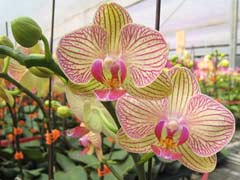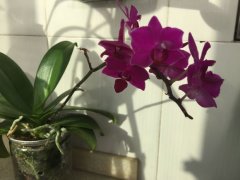Can I spray orchids with lots of flowers?
A flower friend asks how many flowers can be sprayedOrchidIs there, there are many kinds of Huaduoduo, the more common ones are Huaduoduo No. 1 and No. 2, of which Huaduoduo No. 1 is a general-purpose fertilizer with balanced nitrogen, phosphorus and potassium, and No. 2 mainly promotes flowers, and contains good phosphorus and potassium fertilizers, butOrchidIt is a oligo-fertilizer plant, which means that the demand for fertilizer is not very large. Even if the fertility is insufficient, it will not cause fatal damage to the orchid plant, and it will not cause too much impact on the growth and development of the orchid plant, but excessive fertilization orImproper control of fertility will have varying degrees of negative effects on orchid plants, and severe cases can lead to death.
Then florists asked if you can spray orchids for a lot of flowers. Pay attention here. First of all, don’t worry. If you want to fertilize orchids, you must be thinner. The lower the concentration, the better. This is when combined with usual spraying to increase humidity.Add a little thin fertilizer, just give it once every 7 days or so, no top dressing like other plants.
Although orchids do not have a high demand for fertilizers, it does not mean that they cannot be fertilized. It mainly depends on whether we can grasp the concentration and frequency so as not to cause fat damage.
1. Germination period: 8-18 degrees Celsius in spring is the germination temperature of the orchid plant. During this period, the root system of the orchid plant recovers, the reed head awakens, and the mother cell becomes active. After spraying Huabao No. 4 to urge Su fertilizer twice, waterWhen the garland bacteria king Eli germinates, there is no sign of growth on the surface of the orchid plant during this period. Weak seedlings must be allowed to continue to sleep and fertilize later.
2. Growth period: 12-20 degrees Celsius is the normal growth temperature of orchid plants. At this time, the roots of orchid plants begin to stretch. Last autumn buds broke the soil ahead of schedule. The new shoots were also eager to try. It was the golden period of orchid plant growth and development.For orchid plant water and fertilizer management, it is better to fertilize full-price fertilizer, but also partial nitrogen fertilizer. Nitrogen fertilizer should not be too large, otherwise it will easily cause new seedling leaves to be soft, thin, and large, and easy to cause carbon maggot disease. At this time, the fertilization can be in normal proportionsIrrigate the roots to achieve the purpose of strong buds and strong seedlings, this is the first time to fertilize according to the amount.
3. Vigorous growth period in spring and summer: 20-32 degrees Celsius is the period of vigorous growth of orchid plants. During the rainy season, orchid plants grow rapidly during this period. Although orchid plants need a lot of fertility at such a temperature, we haveIrrigation root fertilizer for time still remains in the pot there is little or no coarse material, so continue to fertilize, so the root fertilizer must be thin at this time to reduce the risk of fattening the orchid plant when the temperature rises.Phosphorus and potassium fertilizers are the main fertilizers, full-price fertilizers can also be used, no or less nitrogen fertilizers. This period of time isPests and diseasesIn the high-incidence period, strengthen ventilation and water control, and do a good job in pest control.
4. Stagnation period: refers to the short period of stagnation of orchid plants when the temperature is above 35 degrees Celsius, but there is not much time in a day that is above 35 degrees. In fact, the growth of orchid plants in the high temperature period is the most rapid and the most prone to softening.Rot and rot, in order to prevent corrosion, plus some residual fertilizer amount in the previous fertilization or the plant material itself is very fertile. In the dog days, you should seize the opportunity to increase the amount of watering, and never fertilize.Water 2-3 times, use large water to take away the remaining fertility in the orchid pot, repeat this 3-4 times to make the plant material in the pot light and moderate, which is an important measure for orchid plants to spend the summer safely.
5. The vigorous growth period in autumn: 32-20 degrees Celsius in autumn is the vigorous growth period for orchid plants. Because we dilute the plant material in summer, and the orchid plants need a lot of fertility at this time, root fertilizer should be irrigated in time the second timeDeliberate fertilization, mainly phosphorus and potassium fertilizers.
6. Hibernation period: Orchid plants below 8 degrees Celsius basically stop growing and then enter hibernation. Foliar fertilizer can be sprayed appropriately.
- Related knowledge
- Introduction to the characteristics of Mayor Red Orchid picture
- Does carbendazim cure orchid stem rot?
- Can orchid string disease still be raised?
- Orchid is a herb grown for several years no more than three
- How to deal with the old orchid seedlings cover the old seedlings
- What does orchid vernalization mean? Promote the growth of flower buds
- How to deal with orchids after blooming|How to cut flower stems
- See how veteran flower growers answer these two questions: Is orchid easy to raise? Can newbies raise these two questions
- What's wrong with the yellow leaves of orchids 12 types of yellow leaves
- When is the best time to water orchids | morning and evening
 Phalaenopsis fertilization method
Phalaenopsis fertilization method- Precautions for orchid replacement
- picture of orchid disease
- Orchid is a herb grown for several years no more than three
 How to raise Dendrobium butterfly
How to raise Dendrobium butterfly- Is the orchid fragrance toxic?
- Why do orchids use deep pots, in fact, shallow pots can also be used
 Jianlan green beak blooms in a few months
Jianlan green beak blooms in a few months
- Editor's recommendation
- Molan breeding method
- Introduction of orchids and main rare varieties Chunlan
- Chunlan grass orchid breeding method
- The maintenance method of bottle orchid
- How to grow gladiolus flowers
- The cultivation method of purple root orchid
- Nine-section orchid nine head orchid, nine Hualan cultivation method
- Knowledge of cultivation and maintenance of Buddha bead spider plant watermelon spider plant
- The breeding and maintenance method of yellow pineapple
- Detailed explanation of bluegrass orchid



